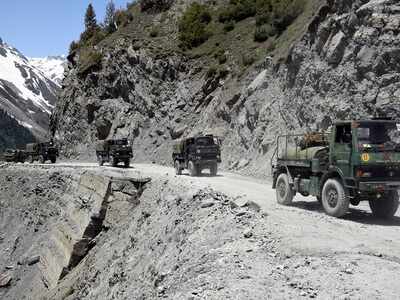Top Searches
- News
- India News
- India-China stand-off: Past pacts prevented pulling the trigger
India-China stand-off: Past pacts prevented pulling the trigger

NEW DELHI: Indian soldiers patrolling in the forward areas along the Line of Actual Control (LAC) with China do carry assault rifles and firearms but when a team goes ahead to confront or talk to PLA troops, they are usually unarmed or have their weapons concealed or slung on their backs.
This, in short, is the standard operating procedure (SOP) followed by Indian troops, who are also under strict instructions to never open fire in accordance with the flurry of border management agreements inked with China over the years. The 1996 agreement, for instance, lays down that “neither side shall open fire or conduct blast operations within 2 km of the LAC”.
India-China border stand-off: Live updates
The brutal killing of 20 Indian soldiers, including the commanding officer of 16 Bihar Colonel B Santosh Babu, by troops of the People’s Liberation Army armed with nail-studded rods and stones in the Galwan Valley region of eastern Ladakh on Monday night has already led the Indian defence establishment to rethink existing SOPs and protocols, as was reported by TOI.
LAC stand-off: Complete coverage
On Thursday, it triggered a huge controversy, with many questioning why the Indian soldiers did not draw their weapons on being faced with a brutal assault. Foreign minister S Jaishankar said troops carried arms but did not use them because of agreements between the two sides not to open fire.
Read also: Some in forces favour ‘limited action’ to send message to China
Many military veterans strongly opposed him.
Former Northern Army commander Lt General H S Panag (retd) tweeted: “These agreements (with China) apply to border management and not while dealing with a tactical military situation. Lastly, when lives of soldiers or security of post/territory threatened, the commander on the spot can use all weapons at his disposal, including artillery.”
Brigadier Sandeep Thapar (retd) said, “If your colonel gets killed in front of you, all rules will be flung out of the window. If the enemy has violated the protocols and carried out offensive action, why should rules of conduct apply?
This, in short, is the standard operating procedure (SOP) followed by Indian troops, who are also under strict instructions to never open fire in accordance with the flurry of border management agreements inked with China over the years. The 1996 agreement, for instance, lays down that “neither side shall open fire or conduct blast operations within 2 km of the LAC”.
India-China border stand-off: Live updates
The brutal killing of 20 Indian soldiers, including the commanding officer of 16 Bihar Colonel B Santosh Babu, by troops of the People’s Liberation Army armed with nail-studded rods and stones in the Galwan Valley region of eastern Ladakh on Monday night has already led the Indian defence establishment to rethink existing SOPs and protocols, as was reported by TOI.
LAC stand-off: Complete coverage
On Thursday, it triggered a huge controversy, with many questioning why the Indian soldiers did not draw their weapons on being faced with a brutal assault. Foreign minister S Jaishankar said troops carried arms but did not use them because of agreements between the two sides not to open fire.
Read also: Some in forces favour ‘limited action’ to send message to China
Many military veterans strongly opposed him.
Former Northern Army commander Lt General H S Panag (retd) tweeted: “These agreements (with China) apply to border management and not while dealing with a tactical military situation. Lastly, when lives of soldiers or security of post/territory threatened, the commander on the spot can use all weapons at his disposal, including artillery.”
Brigadier Sandeep Thapar (retd) said, “If your colonel gets killed in front of you, all rules will be flung out of the window. If the enemy has violated the protocols and carried out offensive action, why should rules of conduct apply?
FacebookTwitterLinkedinMail
Start a Conversation
end of article
Trending Topics
Quick Links
Coronavirus in MumbaiCoronavirus in KolkataCoronavirus in HyderabadCoronavirus in DelhiCoronavirus in BangaloreCoronavirus symptomsCoronavirus in IndiaWhat is CoronavirusCoronavirus NewsSolar EclipseNPRWhat is NRCCAB BillCAB and NRCRTI BillPodcast newsLok SabhaShiv SenaYSRCPCongressBJP newsUIDAIIndian ArmyISRO newsSupreme Court